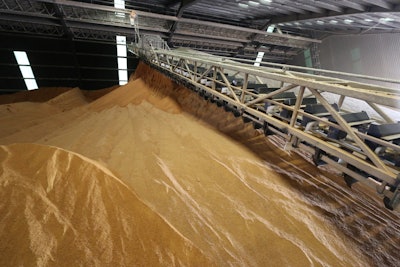
实施20多年后,北美自由贸易协定continues to help boost agricultural trade between Canada, Mexico and the United States, helping support sales of U.S. commodity corn to feed Mexican livestock, promote emerging sectors in Mexico like craft brewery and more. However, the impacts of this agreement on U.S. agriculture haven’t just happened — they are the result of strong trade policy and market development support from organizations like the U.S. Grains Council (USGC) that help local industry build their own successes.
The path to opening trade
Before NAFTA was implemented, Mexico had protectionist regulations in place such as import substitution policies, restrictions on foreign investment and a controlled exchange rate, the combination of which caused that market to become known as one of the world’s most protected economies.
This started to change in the mid-1980s when Mexico faced a debt crisis that forced the government to take steps to open and modernize its economy through trade liberalization. But it wasn’t until NAFTA entered into force that Mexico truly became open to trade with the United States.
When NAFTA was in the process of being negotiated, about 60% of U.S. agricultural exports to Mexico required import licenses, and there were numerous nontariff barriers, such as official import prices, that hurt U.S. agricultural trade with Mexico. Today, NAFTA has phased out all tariffs on U.S. feed grains imported into Mexico, which has helped spur Mexico’s demand growth for U.S. grains and, in turn, a steady expansion in Mexico’s livestock and poultry sectors.
However, while NAFTA removed barriers to trade, importers and end users needed education on how to negotiate, purchase and use U.S. coarse grains and co-products in their rations. That’s where the Council came in on behalf of U.S. farmers and agribusinesses.
The Council opened an office in Mexico City in 1982 to serve our southern neighbor. After NAFTA was ratified, our programs became focused on educating the entire grains value chain from feed importer to livestock producer on topics ranging from feed formulation to forward contracting to livestock genetics.
As the livestock sector matured in Mexico, our strategic plan evolved accordingly, and we began incorporating programs that were focused on maximizing the U.S. marketing advantage in Mexico and expanding U.S. sales of coarse grains and co-products to that country. Now, USGC programs touch all pieces of potential feed grain demand.
U.S. corn sales to Mexico booming
The power of open trade and a buyer’s market is on display this marketing year in Mexico. While U.S. corn exports have faced challenges in the early part of the 2015/2016 marketing year, Mexico remains a bright spot, having imported 10.3 million metric tons (405 million bushels) of U.S. corn as of March 10 for this marketing year, 1.6 million tons (62.3 million bushels) more than last year at the same time.
Factors impacting this surge include new market dynamics with drought-stricken South Africa needing more corn than normal and Mexico’s shift away from purchasing U.S. sorghum, which historically was our top market for this commodity. In addition, Mexico’s economy is continuing to grow, which is leading to higher consumption of meat, dairy and eggs among the country’s middle class. In turn, this is leading to a higher demand for coarse grains and co-products.
As the growing feed sector in Mexico continues to increase its demand for corn, the Council is working to capitalize on this need through our programming efforts in Mexico, such as seminars and one-on-one meetings to present the findings of corn quality reports to interested buyers and end users.
Promoting U.S. DDGS to Mexican end users, buyers
Mexico’s growing demand for feed ingredients is also important in our work to develop interest in U.S. distiller’s dried grains with solubles (DDGS). Last year alone, Mexico imported more than 1.5 million tons of DDGS, making it the second largest market for this corn co-product.
Despite these imports, there is substantial potential to surpass 2 million tons of sales by providing technical education in the livestock sector and opening new markets such as tropical beef and dual purpose cattle.
Increasing inclusion levels in feedlot operations and in some of the country’s largest swine integrators will be one of the keys to reaching this goal. Additionally, a number of potential consumers still lack proper education for purchasing, feeding, storing and formulating with DDGS and have a general misunderstanding of the product, which we are working to address through market development and trade servicing programs.
In addition, there is still considerable potential to increase DDGS exports to the country’s Southeast region. The area contains a large number of beef, dairy, dual-purpose cattle and swine herds that have little or no exposure to DDGS. Distribution is one of the most important limiting factors to expanding the market in this region due to a poorly developed supply chain.
The Council has experienced some success with its DDGS promotion program in this region and recently reached an important milestone with U.S. DDGS beginning to flow to Southern Mexico on a commercial scale.
Mexico program looks for new opportunities in beer industry
With Mexico’s proximity to the United States and the free trade advantages it enjoys under NAFTA, Mexican brewers importing U.S. barley or barley malt receive both economic and logistical benefits. However, the brewing industry in Mexico has gone through important changes in the past few years that make our work within this market even more vital.
Due to antitrust measures,
ABInBev was forced to sell one of their brewing operations to Constellation Brands International following its purchase of Modelo, creating a third brewing company in Mexico that will eventually need to import malting barley and barley malt. The need for products from these three groups gives us the opportunity to introduce new buying schemes and strengthen existing supply relationships.
In addition, the Mexican craft brewery sector has been growing each year almost exponentially, while early starters are becoming more consolidated and have invested in their breweries to sustain growth.
Because of this dynamic, new companies are being created to service craft brewers, first with equipment and now with ingredients.
Craft brewery growth is currently hindered because breweries find it difficult to obtain barley malt and other inputs for the beer they produce. They are also faced with challenges importing ingredients from Europe under the tariff rate quota (TRQ) because the large breweries control this quota.
The Council is working to educate this industry on U.S. malt as it can be imported at any time thanks to NAFTA and can perform equally to European malt.
Monopolies, reform policies, MTBE and U.S. ethanol exports
U.S. ethanol exports to Mexico also have the potential to happen in the near future as reforms in the country’s energy policy are changing the picture for U.S. exports there. Pemex’s monopoly is set to end in 2017, and gasoline and diesel prices will no longer be set by the government in 2018. This means that in a few years’ time, Pemex will need to be competitive in the international marketplace.
In March 2015, Pemex announced its plan to introduce its first-ever blend of gasoline mixed with ethanol and has since awarded six contracts to local ethanol plants. Under Mexican law, these plants are prohibited from the domestic production of corn-based ethanol, but it is clear that domestic sugarcane production can only meet a portion of the ethanol fuel supply potential in Mexico. This could create a need for U.S. exports of ethanol to the market, which will be tariff-free under NAFTA.
However, U.S. ethanol exports to Mexico will only occur if the economics are favorable and the ethanol blender or gasoline distributor has an incentive to change the existing fuel distribution system in favor of using ethanol.
Mexico interest in U.S. sorghum strong despite tight world market
While DDGS and ethanol exports have the potential for expansion, U.S. sorghum exports to Mexico have dropped significantly due to rising world demand, especially from China.
In the 2012/2013 marketing year, Mexico was the top importer of U.S. sorghum and purchased more than 2.1 million tons (82.7 million bushels) valued at nearly $585 million. However last marketing year, Mexico only bought 3,000 tons (118,104 bushels) of U.S. sorghum.
This market shift has led to intense interest among Mexican buyers about future developments for U.S. sorghum supply. However, while China has been a big competitor for U.S. sorghum as of late, we believe that between increases in U.S. sorghum production, NAFTA and the Council’s work to connect U.S. producers and Mexican buyers, we will once again see U.S. sorghum exports pick up.
Trade liberalization needed around the world
Mexico has been and will remain an important market for U.S. coarse grains and co-products. It’s also a textbook example of why the United States should continue to pursue trade agreements that remove barriers to new sales.
Since the end of World War II, our country has only negotiated agreements with 20 countries, an important but small collection when compared to the more than 260 trade agreements in place around the world.
If we want to continue to take advantage of emerging export opportunities — and to maintain the United States’ competitiveness — trade liberalization must occur at all levels including bilateral, regional and multilateral. NAFTA has helped the United States accomplish this in the Western Hemisphere — and now it’s time to accomplish this around the world.





















